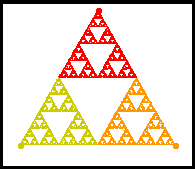|
April 10, 1999 The third session of the Saturday Exploration Club, begins with a review of randomness. Dr. Robert Panoff, Bob1, throws a die on the table several time to show the randomness that the die displays. "How many heads are there on the quarter," Bob1 ask rep eating a question he posed in an earlier session. The explorers remember the answer and says that they saw thirteen heads. Bob1 then ask if they did this experiment in the spring of 1981 would the answer be the same. The explorers agree saying that the quarter was the same then as it is now. Bob1 then ask, "If this experiment was performed on April 1999 how many heads are there on the quarter?" "You couldn't get the same answer," says Ryan, "because they have made some new quarters." This example le ads to the explanation of the mathematical concepts of mean, mode, and medium, to help them better understand ways of taking averages. The explorers next play a game. They first make an equilateral triangle and label the three points of the triangle. The explorers assume that the piece of paper where the triangle is located is the entire world, they then place a point somewhere in the "world". See example below:
 They label each point with two numbers of the die. They first roll the die, taking this number they placing it halfway between the starting point and the point of the number rolled. After doing this several times the noticed that the dots appeared in a random fashion. So, Bob1 takes the explorers into the computer lab and they use a web-based program that does the same thing that they were doing with the die. The explorers immediat ely see how the program accelerates the process of placing the dots. After a brief observation of the program, the explorers notice that the program would allow them to place several dots. Using a large number of dots, the explorers notice that the dots eventually resembles the original dot.  The explorers then take a short break away from the computers. Next, the explorers view some of the activities that The Shodor Education Foundation, Inc. have created based on patterns and self-referring accurances. T hey use tools such as Snowflake. Bob1 then draws a figure on the board and tell the explorers to try to redraw this figure on their computer. When they increase the step size of th e image, they notice that triangles appear on the sides of the original figure. The explorers then view the enhanced version of the snowflake site. On this version the explorers create a figure that is not overlapping and apply the snap-to-grid function . They then increase the iterations and see why it is related to chaos. "You make a small change and you get a completely different result," Bob1 says ending the session. His final statement is proven when the explorers attempt to write their reports o n the web and they try one letter wrong while trying to access the web site, they are unable to access the page.
Last Update: Please direct questions and comments about this page to WebMaster@shodor.org © Copyright 1999 The Shodor Education Foundat ion, Inc. |

